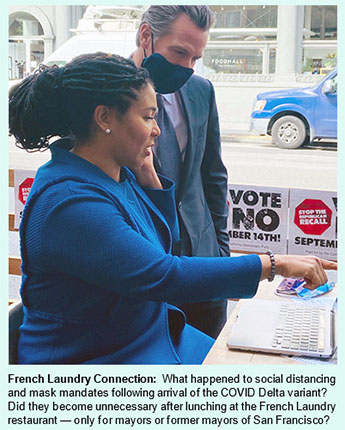 Printer-friendly PDF file
Printer-friendly PDF fileAugust 22, 2021
California Wildfires and PG&E Bailout Play a Big Role
Will Newsom Escape Recall?
by Patrick Monette-Shaw
Many people are questioning whether Governor Gavin Newsom will escape being recalled. It’s a valid question at this late date.
As of August 16, polls showed Newsom had lost ground in recent polling about his prospects to survive the recall election on September 14. Newsom was in a dead heat, with 52% of likely registered voters opposing recall, and 48% supporting recall. The margin of error of the polling wasn’t announced, but it bodes ill for Governor Gavin.
An August 18 analysis of other polls by Nate Silver’s FiveThirtyEight polling aggregation website shows that 48.8% of voters are against (“No”), and 47.6% are for it (“Yes”). Newsom’s one-point margin is extremely thin, and may worsen; he needs 50%+1 (“No”) to survive, so he’s under water.
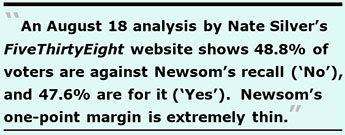 Newsom’s situation is so dire, I received U.S. Mail on August 17 from the California Democratic Party asserting the recall election is tightening and extremely close, and begging me to donate up to $2,500 to help Newsom save his job. I’m a retiree and don’t have that kind of disposable income sitting in my bank account. That’s putting aside that I wouldn’t spend that level of a political campaign donation to save Newsom his job, because there are too many other deserving Democrats facing tough national election and re-election contests next year whom I desperately want to support. Newsom won’t get a dime from me, any more than I’d give Donald Trump one of my dimes.
Newsom’s situation is so dire, I received U.S. Mail on August 17 from the California Democratic Party asserting the recall election is tightening and extremely close, and begging me to donate up to $2,500 to help Newsom save his job. I’m a retiree and don’t have that kind of disposable income sitting in my bank account. That’s putting aside that I wouldn’t spend that level of a political campaign donation to save Newsom his job, because there are too many other deserving Democrats facing tough national election and re-election contests next year whom I desperately want to support. Newsom won’t get a dime from me, any more than I’d give Donald Trump one of my dimes.
What the California Democratic Party didn’t know was that I had already received my ballot from the San Francisco Department of Elections on August 13, filled it out the same day, and sent it back the following day on Friday, August 14. I had already returned my ballot before learning I had inadvertently voted the way Newsom later recommended — which recommendation may well end up spelling his own doom.
I won’t be at all surprised if Newsom doesn’t escape unscathed.
 For the first half of August, the Bay Area was inundated by a single TV ad broadcast almost non-stop opposing Newsom’s recall. The ad featured — somewhat ironically — only U.S. Senator Elizabeth Warren, a dyed-in-the wool “progressive” Democrat, who is supporting “moderate” Gavin Newsom. Warren’s unchanged ads claimed Republicans have “abused [California’s] recall processes.”
For the first half of August, the Bay Area was inundated by a single TV ad broadcast almost non-stop opposing Newsom’s recall. The ad featured — somewhat ironically — only U.S. Senator Elizabeth Warren, a dyed-in-the wool “progressive” Democrat, who is supporting “moderate” Gavin Newsom. Warren’s unchanged ads claimed Republicans have “abused [California’s] recall processes.”
Tell that to victims of California’s wildfires, plenty of whom may suspect Newsom’s time in office involves misconduct, and/or political corruption.
Warren may not have understood California’s recall processes are limited to breaches of office, serious misconduct, or corruption, not just political disagreements between the two major political parties. The case for Newsom’s recall for breaches of office, misconduct, or corruption may not be that weak.
News surfaced on August 17 reporting Newsom pledged stronger wildfire responses during his visit to the devastated Big Basin State Park near Boulder Creek in Santa Cruz County. Newsom claimed hiring more firefighters, increasing forest management, and deploying new weather monitoring technology were priorities in spending the state’s nearly $80 billion budget surplus this year. Given the devastation from wildfires that have happened since 2017 — and in particular, wildfires occurring now in 2021 — Newsom should have pledged stronger wildfire responses long before now.
 Perhaps the recall election caused Newsom to make new, albeit belated, pledges. California’s wildfires may well be something voters care about deeply as they consider how to vote on his recall.
Perhaps the recall election caused Newsom to make new, albeit belated, pledges. California’s wildfires may well be something voters care about deeply as they consider how to vote on his recall.
Newsom’s 2019 “Brokerage” Role in AB-1054 to Protect PG&E
As far back as when Newsom was San Francisco’s mayor, his cozy relationship with PG&E was of great concern to San Franciscans worried about corruption in his City Hall “family.” After he became Lieutenant Governor in 2011, Newsom’s cozy relationship with PG&E continued unabated.
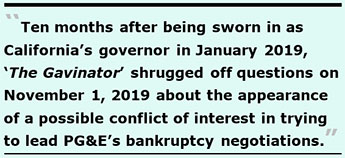 Ten months after being sworn in as California’s governor in January 2019, “The Gavinator” — as Newsom nicknamed himself — shrugged off questions during a TV broadcast back on November 1, 2019 “about the appearance of a possible conflict of interest in trying to lead PG&E’s bankruptcy negotiations, insisting that he [was] not swayed by the $208,400 donation PG&E made to help him win the 2018 election.”
Ten months after being sworn in as California’s governor in January 2019, “The Gavinator” — as Newsom nicknamed himself — shrugged off questions during a TV broadcast back on November 1, 2019 “about the appearance of a possible conflict of interest in trying to lead PG&E’s bankruptcy negotiations, insisting that he [was] not swayed by the $208,400 donation PG&E made to help him win the 2018 election.”
The TV report involved Newson’s announcement his “office would seek to ‘broker’ a deal to end PG&E’s bankruptcy,” and that Newsom had “inserted himself into a massively complex fight that pits fire victims, governments, shareholders, and bondholders against each other. Tens of billions of dollars [were] at stake.” Not directly mentioned, but entirely relevant, PG&E’s own ratepayers — me included — wound up pitted against everybody else.
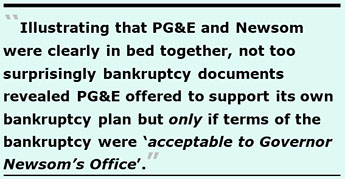 PG&E filed for bankruptcy protection on January 29, 2019 to shield itself from an estimated $30 billion in wildfire liabilities, including four wildfires that killed a total of 97 people in 2018: The Carr fire, Mendocino Complex fire, Woolsey fire, and Camp fire, the latter of which killed 85 people and destroyed the Town of Paradise. That was on top of the 22 people who died as a result of the Tubbs fire in October 2017.
PG&E filed for bankruptcy protection on January 29, 2019 to shield itself from an estimated $30 billion in wildfire liabilities, including four wildfires that killed a total of 97 people in 2018: The Carr fire, Mendocino Complex fire, Woolsey fire, and Camp fire, the latter of which killed 85 people and destroyed the Town of Paradise. That was on top of the 22 people who died as a result of the Tubbs fire in October 2017.
Illustrating that PG&E and Newsom were clearly in bed together, not too surprisingly bankruptcy documents revealed PG&E offered to support its own bankruptcy plan but only if terms of the bankruptcy were “acceptable to Governor Newsom’s Office.” Don’t hog the bedclothes, Gavinator.
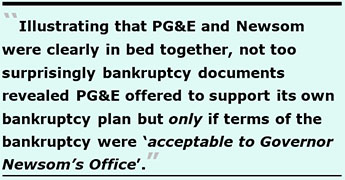 Less than a month after PG&E filed for bankruptcy and just two months after Newsom became governor, a bill was introduced in the California Assembly on February 22, 2019 — AB-1054, Public utilities: wildfires and employee protection — that would take effect immediately as an urgency statute.
Less than a month after PG&E filed for bankruptcy and just two months after Newsom became governor, a bill was introduced in the California Assembly on February 22, 2019 — AB-1054, Public utilities: wildfires and employee protection — that would take effect immediately as an urgency statute.
Some PG&E critics believe Newsom gave the company a priceless gift in the form of the hastily-written and hastily-passed AB-1054 that was aimed at protecting power monopolies from financial trouble when they start future wildfires.
Fire – Power – Money
Luckily, Sacramento-based ABC Channel 10 has been broadcasting a series of articles entitled “Fire – Power – Money” since 2019 examining connections between California’s wildfires, PG&E, and PG&E’s influence on California politics. The series of articles are by investigative reporter Brandon Rittiman, a 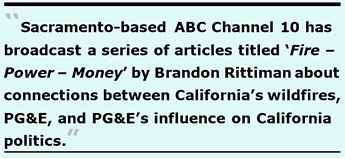 graduate of the Walter Cronkite School of Journalism and Mass Communication at Arizona State University, who is a winner of regional Emmy awards and other awards. Fortunately, ABC Channel 7 in San Francisco has re-broadcast many of the segments in Rittiman’s Fire – Power – Money three seasons of episodes. They’ve probably been re-broadcast by other ABC TV affiliates in California.
graduate of the Walter Cronkite School of Journalism and Mass Communication at Arizona State University, who is a winner of regional Emmy awards and other awards. Fortunately, ABC Channel 7 in San Francisco has re-broadcast many of the segments in Rittiman’s Fire – Power – Money three seasons of episodes. They’ve probably been re-broadcast by other ABC TV affiliates in California.
Rittiman’s investigative series reveals how California’s state government under Newsom responded to PG&E’s deadly crimes by granting the company rewards and protection.
Rittiman’s reporting revealed that in October 2019 the California PUC approved a ratepayer surcharge to pay for a $21 billion wildfire fund that the state’s three big power companies can tap if their equipment ignite a wildfire that results in significant damages, provided the PUC determines the utilities had acted responsibly.
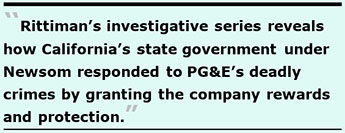 AB-1054 requires investor-owned utilities San Diego Gas & Electric, Southern California Edison, and PG&E to pony up half of the money in the $21 billion fund. The other $10.5 billion half comes from ratepayers across the state. One problem is that PG&E tied its share of contributions to wildfire victims by issuing shares in the company, which stocks have dropped precipitously in value. The loss in stock value has lowered PG&E’s compensation to victims of wildfires.
AB-1054 requires investor-owned utilities San Diego Gas & Electric, Southern California Edison, and PG&E to pony up half of the money in the $21 billion fund. The other $10.5 billion half comes from ratepayers across the state. One problem is that PG&E tied its share of contributions to wildfire victims by issuing shares in the company, which stocks have dropped precipitously in value. The loss in stock value has lowered PG&E’s compensation to victims of wildfires.
Between May 2019 and January 2021, my monthly PG&E bill more than doubled, including the now monthly “Wildfire Fund Charge” surcharge the California Public Utility Commission granted to PG&E following adoption of AB-1054 to help PG&E out of bankruptcy.
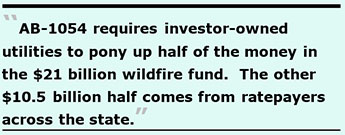 Under AB-1054, power companies were required to receive a first-of-its-kind safety certification from the state. In order to tap the wildfire fund, the companies must tie executive compensation to safety performance, establish wildfire safety committees on their respective boards, and meet other financial and safety measures. PG&E received its first safety certificate in 2020.
Under AB-1054, power companies were required to receive a first-of-its-kind safety certification from the state. In order to tap the wildfire fund, the companies must tie executive compensation to safety performance, establish wildfire safety committees on their respective boards, and meet other financial and safety measures. PG&E received its first safety certificate in 2020.
California’s PUC again certified PG&E as an officially “safe” utility for a second time in April 2021 under AB-1054 that Newsom had signed into law in 2019. The CPUC granted the electric monopoly its 2021 state safety certificate even though PG&E was charged in April 2021 with 33 crimes for sparking the 2019 Kincade Fire, is under investigation for possible murder charges from the 2020 Zogg Fire that killed four people, and had plead guilty in 2020 to 84 felony counts of manslaughter and one other felony for sparking the 2018 Camp Fire. All that was after a jury convicted PG&E in August 2016 for six felonies in the deadly 2010 San Bruno gas explosion.
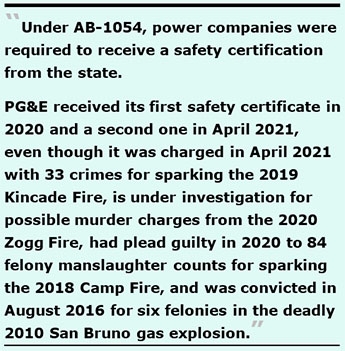 AB-1054 essentially helped bail PG&E out of bankruptcy, and provides that utility companies pre-certified with safety certificates as being “safe” aren’t required to prove they had acted reasonably before charging customers for costs of damages caused by wildfires, grants the utility companies the ability to tap into the state wildfire fund paid in part by their customers to pay damages to fire victims, and — disgustingly — caps [limits] the amount of damages utility shareholders would be on the hook for paying back to the wildfire fund, which in turn cuts compensation to actual wildfire victims.
AB-1054 essentially helped bail PG&E out of bankruptcy, and provides that utility companies pre-certified with safety certificates as being “safe” aren’t required to prove they had acted reasonably before charging customers for costs of damages caused by wildfires, grants the utility companies the ability to tap into the state wildfire fund paid in part by their customers to pay damages to fire victims, and — disgustingly — caps [limits] the amount of damages utility shareholders would be on the hook for paying back to the wildfire fund, which in turn cuts compensation to actual wildfire victims.
Many believe the safety certificates were just rubber stamped. Given allegations of PG&E’s criminal culpability, it’s not known why Newsom and California’s Legislature decided awarding PG&E safety certificates could be justified.
Former California PUC director Alice Stebbins — who signed PG&E’s first safety certificate — claims she was told to sign it, and signed it because AB-1054 had essentially made PG&E’s certificate automatic, not that PG&E had actually become safe. Stebbins is pursuing a wrongful termination lawsuit against the state government alleging she was fired by PUC commissioners who are appointed by California governors because of her investigation of $200 million missing from CPUC’s books. A ProPublica investigation subsequently revealed Stebbins had been correct.
In an August 10, 2021 broadcast Rittiman reported Newsom had not only signed the new financial protections for PG&E into law, Newsom’s office had hired private lawyers at the New York offices of the O’Melvany and Myers law firm to draft the legislative language of AB-1054 in the Spring of 2019 before it was introduced in the state legislature. O’Melvany and Myers reportedly billed the state $3 million for its services drafting AB-1054.
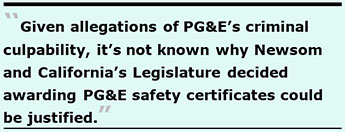 In an August 11, 2021 segment, Rittiman reported that Newsom had brokered a bankruptcy plan that prioritized PG&E and French Laundry friend’s clients over PG&E fire victims. That’s when we belatedly learned Newsom’s 2020 French Laundry restaurant fiasco involved a birthday party for Newsom’s friend of almost 20 years, lobbyist Jason Kinney. Newsom apologized profusely for the French Laundry dinner, claiming “he was only human.”
In an August 11, 2021 segment, Rittiman reported that Newsom had brokered a bankruptcy plan that prioritized PG&E and French Laundry friend’s clients over PG&E fire victims. That’s when we belatedly learned Newsom’s 2020 French Laundry restaurant fiasco involved a birthday party for Newsom’s friend of almost 20 years, lobbyist Jason Kinney. Newsom apologized profusely for the French Laundry dinner, claiming “he was only human.”
Kinney ran a lobbying shop, Axiom Advisors, that had landed a major client in PG&E’s bankruptcy, a committee of companies PG&E owed money to. Axiom Advisors met periodically with the Governor’s office, and earned $400,000 in fees according to documents filed in bankruptcy court.
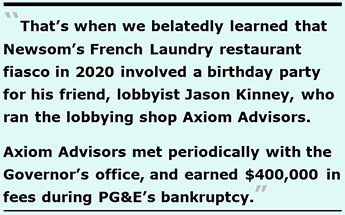 Rittiman’s investigative reporting about PG&E and California’s wildfires have been just terrific, despite the fact that Newsom and the governor’s office not only ducked answering many questions Rittiman had asked, Newsom and his office also stalled records requests under the California Public Records Act (CPRA), and declined or ignored Rittiman’s ten requests for interviews.
Rittiman’s investigative reporting about PG&E and California’s wildfires have been just terrific, despite the fact that Newsom and the governor’s office not only ducked answering many questions Rittiman had asked, Newsom and his office also stalled records requests under the California Public Records Act (CPRA), and declined or ignored Rittiman’s ten requests for interviews.
The Mercury News reported on July 21, 2021 that PG&E claims it plans to place 10,000 miles of power lines underground to reduce the possibility of sparking massive wildfires in Northern and Central California, asserting the 10,000 miles of undergrounding could cost up to $20 billion. California’s Utility Reform Network (TURN) estimates it will cost double that, possibly $40 billion, but it will probably take a decade before any such work will be completed. PG&E will most likely con the California PUC into another rate increase that will be tacked on to ratepaying customer’s PG&E monthly bills. [I can hardly wait to see my PG&E bill climb yet again.]
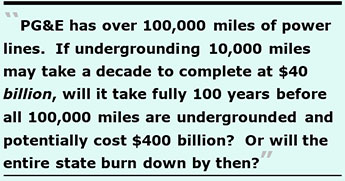 PG&E has over 100,000 miles of power lines. If undergrounding 10,000 miles of those power lines may take a decade to complete at $40 billion, will it take fully 100 years before all 100,000 miles are undergrounded and potentially cost $400 billion? Or will the entire state burn down by then?
PG&E has over 100,000 miles of power lines. If undergrounding 10,000 miles of those power lines may take a decade to complete at $40 billion, will it take fully 100 years before all 100,000 miles are undergrounded and potentially cost $400 billion? Or will the entire state burn down by then?
For its part, KTVU Channel 2 reported in July 2018 that PG&E had been diverting money away from its power line undergrounding projects for decades to what PG&E called “other high priority system improvements.” Channel 2 reported that in 2000, PG&E claimed there had been zero unspent dollars on power line undergrounding, but according to documents by 2016 nearly $44 million dollars had been left unspent. KTVU reported that according to the California PUC’s own study of its statewide undergrounding program revealed there was a statewide balance of unused undergrounding money totaling about $1 billion.
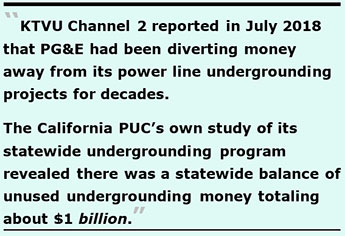 As of 2021, even after massive fines and criminal conviction of PG&E the corporation is reportedly still handing out significant bonuses to PG&E executives.
As of 2021, even after massive fines and criminal conviction of PG&E the corporation is reportedly still handing out significant bonuses to PG&E executives.
PG&E Induced Wildfires
It’s thought that since 2010, wildfires PG&E appears to have caused have destroyed 20,000-plus homes and displaced very large numbers of people. The Camp fire alone displaced approximately 40,000 people.
A quick review of deaths between 2010 and 2020 caused by PG&E-related wildfires and the San Bruno gas pipeline explosion compiled from a mix of civil settlements, CAL FIRE determinations, and felony convictions (including conviction for the Camp fire) revealed 143 deaths between the Butte fire, NorCal Firestorms (including the Tubbs fire), Camp fire, Zogg fire, and the San Bruno explosion. The 143 deaths included one suicide following the Camp fire, and 22 deaths from the Tubbs fire that CAL FIRE had cleared PG&E of, but which PG&E paid civil damages for anyway during its bankruptcy proceedings.
 That averages 13 deaths per year.
That averages 13 deaths per year.
Recent California Wildfires
Take the recent history of wildfires in California. While it is clearly true that climate change-induced years of statewide drought have contributed to California’s increasingly catastrophic wildfires, bad actions of electric and gas companies — think PG&E — have clearly contributed to our State’s wildfire problems.
Consider Wikipedia’s lists of California wildfires that are based on data from the California Department of Forestry and Fire Protection, a.k.a., CAL FIRE. [Note: The following data does not suggest that PG&E was responsible for every one of the 20 largest, the 20 most destructive, or the 20 deadliest fires documented on Wikipedia.]
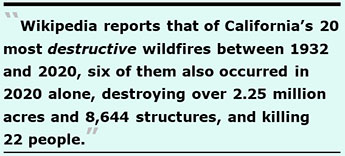 Most Destructive Fires: Wikipedia reports that of California’s 20 most destructive wildfires between 1932 and 2020, six of them also occurred in 2020 alone, destroying over 2.25 million acres and 8,644 structures, and killing 22 people. Those six fires include the North Complex fire, the Glass fire, the LNU Lightning Complex fire, the CZU Lightning Complex fire, the August Complex fire, and the Creek fire.
Most Destructive Fires: Wikipedia reports that of California’s 20 most destructive wildfires between 1932 and 2020, six of them also occurred in 2020 alone, destroying over 2.25 million acres and 8,644 structures, and killing 22 people. Those six fires include the North Complex fire, the Glass fire, the LNU Lightning Complex fire, the CZU Lightning Complex fire, the August Complex fire, and the Creek fire.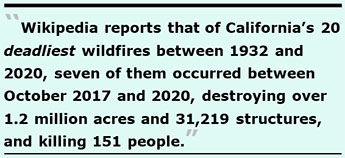 Deadliest Fires: Wikipedia reports that of California’s 20 deadliest wildfires between 1932 and 2020, seven of them occurred between October 2017 and 2020, destroying over 1.2 million acres and 31,219 structures, and killing 151 people. Those seven fires include the North Complex fire, the LNU Lightning Complex fire, the Camp fire, the Carr fire, the Atlas fire, the Redwood Valley Complex fire, and the Tubbs fire. [Note: Newsom became California’s Lieutenant Governor in January 2011; he’s known about California’s worsening wildfires for over a decade.]
Deadliest Fires: Wikipedia reports that of California’s 20 deadliest wildfires between 1932 and 2020, seven of them occurred between October 2017 and 2020, destroying over 1.2 million acres and 31,219 structures, and killing 151 people. Those seven fires include the North Complex fire, the LNU Lightning Complex fire, the Camp fire, the Carr fire, the Atlas fire, the Redwood Valley Complex fire, and the Tubbs fire. [Note: Newsom became California’s Lieutenant Governor in January 2011; he’s known about California’s worsening wildfires for over a decade.]The Gavinator Ducks Questions
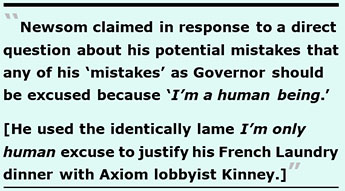 All too frequently Newsom claims he is not naïve (one of his pet claims), but his hubris may be getting the better of him. On August 19, 2021 Newsom was interviewed by ABC Channel 7 in San Francisco. He claimed in response to a direct question about his potential mistakes that any of his “mistakes” as Governor should be excused because “I’m a human being.” [Newsom had used the identically lame I’m only human excuse to justify his French Laundry dinner with Axiom lobbyist Kinney.] Newsom’s naïve excuses ignore that voters are human beings, too, and they’re probably not happy hearing that claim from him yet again.
All too frequently Newsom claims he is not naïve (one of his pet claims), but his hubris may be getting the better of him. On August 19, 2021 Newsom was interviewed by ABC Channel 7 in San Francisco. He claimed in response to a direct question about his potential mistakes that any of his “mistakes” as Governor should be excused because “I’m a human being.” [Newsom had used the identically lame I’m only human excuse to justify his French Laundry dinner with Axiom lobbyist Kinney.] Newsom’s naïve excuses ignore that voters are human beings, too, and they’re probably not happy hearing that claim from him yet again.
The Gavinator also ducked answering a direct question on August 19 about whether he has been delaying issuing additional state COVID-related mandates due to the recall election. Newsom’s evasion answering that question during what is clearly a public health-related COVID–Delta crisis, lowered what little remaining respect I had for him.
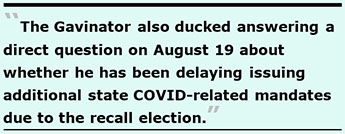 In addition to Newsom’s pathetic record on wildfires and PG&E, there are other issues voters are very concerned about, including the meltdown at California’s Employment Development Department’s (EDD) that handles unemployment claims, which has become a huge political liability to Newsom.
In addition to Newsom’s pathetic record on wildfires and PG&E, there are other issues voters are very concerned about, including the meltdown at California’s Employment Development Department’s (EDD) that handles unemployment claims, which has become a huge political liability to Newsom.
After EDD wrongly paid out over $31 billion in fraudulent EDD claims following the start of the COVID-19 pandemic, thousands of Californians who wound up unemployed had their EDD accounts frozen, unable to collect unemployment benefits despite not having engaged in fraud. Although Newsom reportedly formed a strike team at the very end of July 2020 to overhaul EDD’s outdated technology, he’s largely avoided commenting on the beleaguered department and the plight of the unemployed, knowing it’s likely at the top of mind to a very large number of voters, Democrats and Republicans alike.
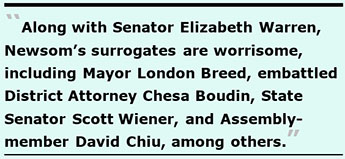 Newsom’s Questionable Surrogates
Newsom’s Questionable Surrogates
Along with Senator Warren, Newsom’s choice of surrogates is worrisome.
On August 13, Newsom kicked off his no-on-recall campaign at an event at Manny’s Restaurant in San Francisco, dragging along some of his surrogates, including Mayor Breed (who was just hit with a large Ethics Commission fine), embattled District Attorney Chesa Boudin (who may soon face his own recall election), State Senator Scott Wiener (who has angered single-family homeowners across the State), and Assemblymember David Chiu, among others. Newsom and these state Democrats are clearly worried the recall election is far closer than they want voters to believe.
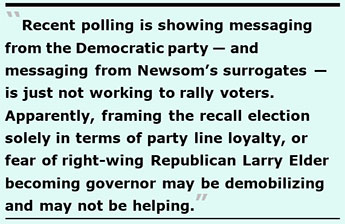 Newsom is in such a precarious position he’s lined up Vice President Kamala Harris (and is hoping to line up President Biden) to come to California on August 27 to help campaign against his recall. That will more than likely be way too late, since many voters will have already had two weeks to return their ballots, as I have. I fully expect a blizzard of campaign mailers will flood my U.S. mailbox in the next three weeks, which will also be far too late and a waste of Newsom’s money.
Newsom is in such a precarious position he’s lined up Vice President Kamala Harris (and is hoping to line up President Biden) to come to California on August 27 to help campaign against his recall. That will more than likely be way too late, since many voters will have already had two weeks to return their ballots, as I have. I fully expect a blizzard of campaign mailers will flood my U.S. mailbox in the next three weeks, which will also be far too late and a waste of Newsom’s money.
Recent polling is also showing that messaging from the Democratic party — and messaging from Newsom’s surrogates — is just not working to rally voters. Apparently, framing the recall election solely in terms of party line loyalty, or fear of right-wing Republican Larry Elder becoming governor may be demobilizing and may not be helping, the opposite of what Newsom desperately needs. Courage California, (formerly named the Courage Campaign), came begging in my e-mail on August 21 for a $75 donation to help Newsom figure out his messaging. They won’t get a dime from me either, despite my disgust and distaste for Mr. Elder. If Newsom can’t figure out his own messaging, why is he governor?
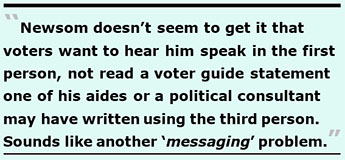 Five days after I voted on August 13, I received the California Voter Guide in U.S. Mail, too late for the guide to have been of any use. I was somewhat shocked skim-reading it and discovering Governor Gavin’s “Governor’s Recall Argument” in the state voter guide was written entirely in the third person, whereas the majority of candidates seeking to replace him should Newsom be recalled wrote their voter guide statements using the first person. Sounds like another “messaging” problem to me.
Five days after I voted on August 13, I received the California Voter Guide in U.S. Mail, too late for the guide to have been of any use. I was somewhat shocked skim-reading it and discovering Governor Gavin’s “Governor’s Recall Argument” in the state voter guide was written entirely in the third person, whereas the majority of candidates seeking to replace him should Newsom be recalled wrote their voter guide statements using the first person. Sounds like another “messaging” problem to me.
Newsom doesn’t seem to get it that voters want to hear him speak in the first person, not read a voter guide statement one of his aides or a political consultant may have written using the third person. Newsom’s statement read eerily like what we’d read from disgraced and disgruntled Donald Trump, asking voters using third-person language “do you distrust Trump?”
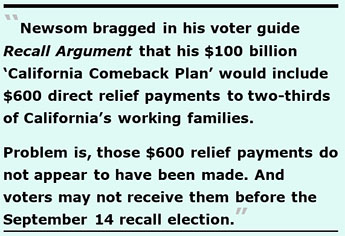 Newsom bragged in his voter guide Recall Argument that his $100 billion “California Comeback Plan” would include $600 direct relief payments to two-thirds of California’s working families. Newsom had announced the relief payments on May 10, 2021 — a mere 14 days after the petition to recall him from office was verified and determined to have a sufficient number of signatures by California’s Secretary of State on April 26. The coincidence in timing between the two dates is odd.
Newsom bragged in his voter guide Recall Argument that his $100 billion “California Comeback Plan” would include $600 direct relief payments to two-thirds of California’s working families. Newsom had announced the relief payments on May 10, 2021 — a mere 14 days after the petition to recall him from office was verified and determined to have a sufficient number of signatures by California’s Secretary of State on April 26. The coincidence in timing between the two dates is odd.
Problem is, those $600 relief payments do not appear to have been made, and voters may not receive them before the September 14 recall election. Is this another messaging problem?
Some observers believe Newsom is showing more gall than desperation, and is out of touch with even likely Democratic voters, given Boudin and his ilk campaigning for Newsom. Some people wonder whether Newsom’s surrogates may have found the event at Manny’s, rather than at the French Laundry, more palatable but still questionable.
Breed’s Ethical Lapses
On August 2, 2021 Breed acknowledged responsibility for and agreed to pay $22,792 in administrative penalties to the San Francisco’s Ethics Commission for four counts of ethics violations of San Francisco Campaign & Governmental Conduct Code. The four counts included two counts for failing to disclose campaign contributions for construction of her 2015 Gay Pride Parade float and the contributions had exceeded the $500 maximum allowable; one count for use of her City title for personal purposes and potential gain in her letter to then-Governor Jerry Brown seeking commutation of her brother’s prison sentence; and one count for accepting gifts from Mohammed Nuru, Breed’s subordinate employee as the then-director of DPW.
For the four-count stipulation, Breed had faced a total of $35,584 in maximum administrative penalties. She got off lucky with the reduced administrative penalty of $22,792 she agreed to pay.
Newsom’s Recall Recommendations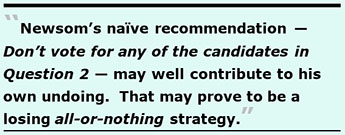
Newsom’s potentially naïve recommendation — Don’t vote for any of the candidates in Question 2 — may well contribute to his own undoing. That may prove to be a losing all-or-nothing strategy.
Many folks, including me, wonder whether Newsom and his campaign team are pursuing an extremely risky strategy by urging voters to vote “no” on the first ballot question involving whether he should be removed from office, and advising voters not to vote at all on the second ballot question of which candidate should replace him if he loses on the first question.
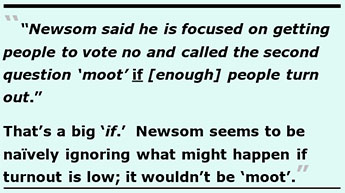 As the [San Jose] Mercury News reported, in response to a question about Newsom’s current strategy and whether it might backfire by on him by effectively allowing Republicans to pick his successor should he lose on the first ballot question, “Newsom said he is focused on getting people to vote no and called the second question ‘moot’ if [enough] people turn out.”
As the [San Jose] Mercury News reported, in response to a question about Newsom’s current strategy and whether it might backfire by on him by effectively allowing Republicans to pick his successor should he lose on the first ballot question, “Newsom said he is focused on getting people to vote no and called the second question ‘moot’ if [enough] people turn out.”
That’s a big “if.” Newsom seems to be naïvely ignoring what might happen if voter turnout is low. It wouldn’t be “moot.” His strategy effectively disenfranchises Democratic voters from choosing who should replace him. That strategy may well end up backfiring on Newsom and his surrogates, handing California a Republican governor who could appointment a successor to 88-year-old U.S. Senator Dianne Feinstein and, therefore also threaten the Biden administration’s agenda along with control of the U.S. House of Representatives and the U.S. Senate, and ignoring that a Republican governor would likely eliminate COVID prevention and vaccination mandates across the state on day one.
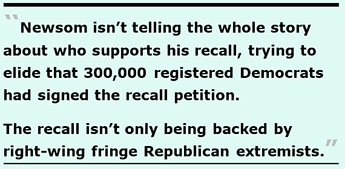 Newsom, Senator Warren, and other Newsom surrogates are desperately trying to frame the recall as a fringe Republican movement backed by right-wing extremists, Trump supporters, and QAnon conspiracy theorists. But Newsom isn’t telling the whole story about who supports his recall, trying to elide that a significant number of Democrats and independent voters — who combined dominate California’s electorate — also signed the recall petitions.
Newsom, Senator Warren, and other Newsom surrogates are desperately trying to frame the recall as a fringe Republican movement backed by right-wing extremists, Trump supporters, and QAnon conspiracy theorists. But Newsom isn’t telling the whole story about who supports his recall, trying to elide that a significant number of Democrats and independent voters — who combined dominate California’s electorate — also signed the recall petitions.
Newsom and his surrogates don’t like mentioning that 300,000 registered Democrats had signed the recall petition, fully 20% of the 1,495,709 minimum petition signatures that were required for the recall petitions to be declared valid. How many Independent voters signed the recall petitions hasn’t been widely reported. Newsom’s response to his recall campaign, and Rittiman’s coverage of PG&E and wildfires, read like a tragic soap opera of Newsom’s own making.
 When I returned my ballot to San Francisco’s Elections Department on Friday the 13th — often a very unlucky day — I did as Newsom later recommended and didn’t vote on Question 2. I may live to regret having done so should Newsom lose on Question 1, since elections have consequences, which is true despite being a cliché.
When I returned my ballot to San Francisco’s Elections Department on Friday the 13th — often a very unlucky day — I did as Newsom later recommended and didn’t vote on Question 2. I may live to regret having done so should Newsom lose on Question 1, since elections have consequences, which is true despite being a cliché.
Monette-Shaw is a columnist for San Francisco’s Westside Observer newspaper, and a member of the California First Amendment Coalition (FAC) and the ACLU. He operates stopLHHdownsize.com. Contact him at monette-shaw@westsideobserver.com.